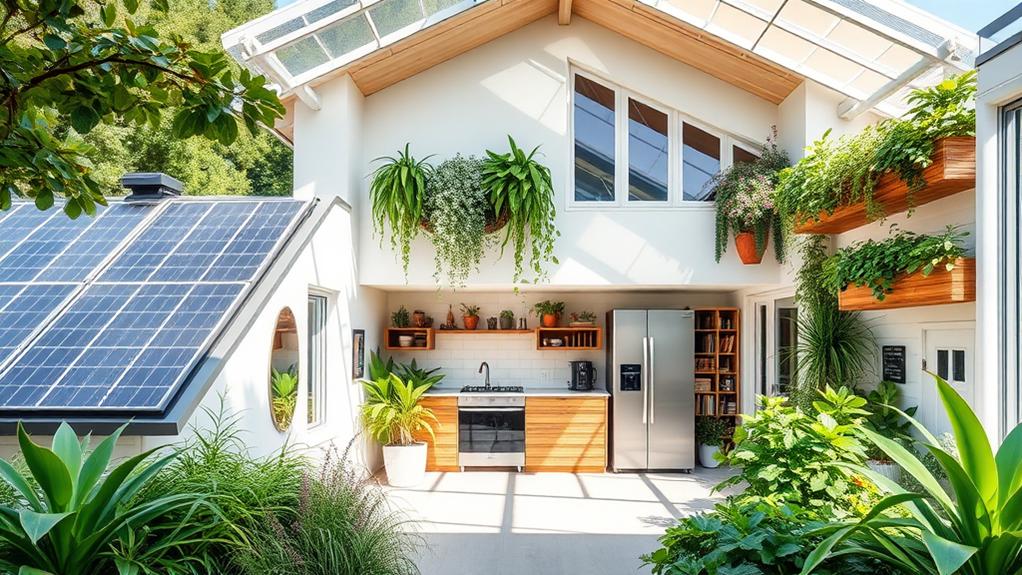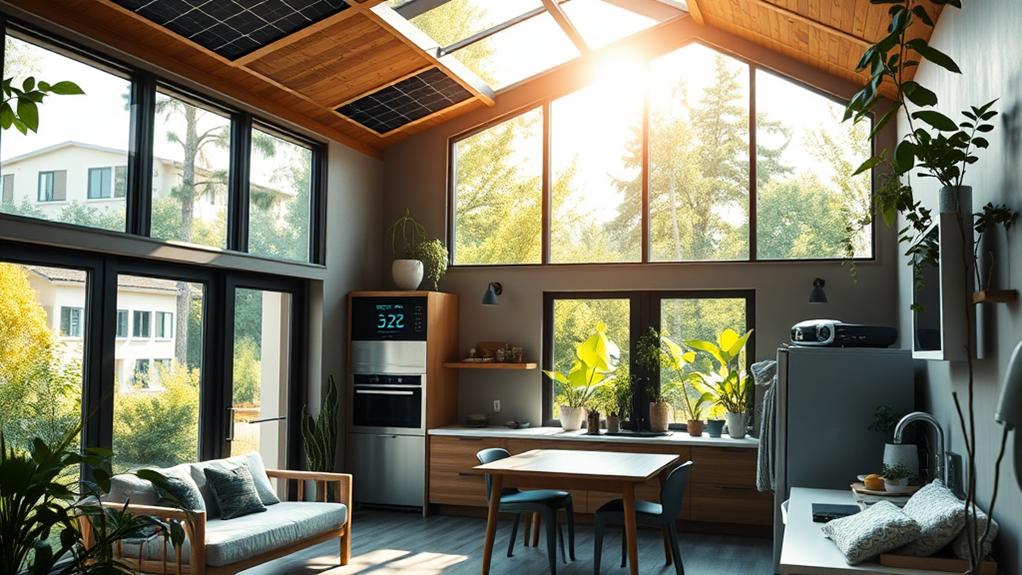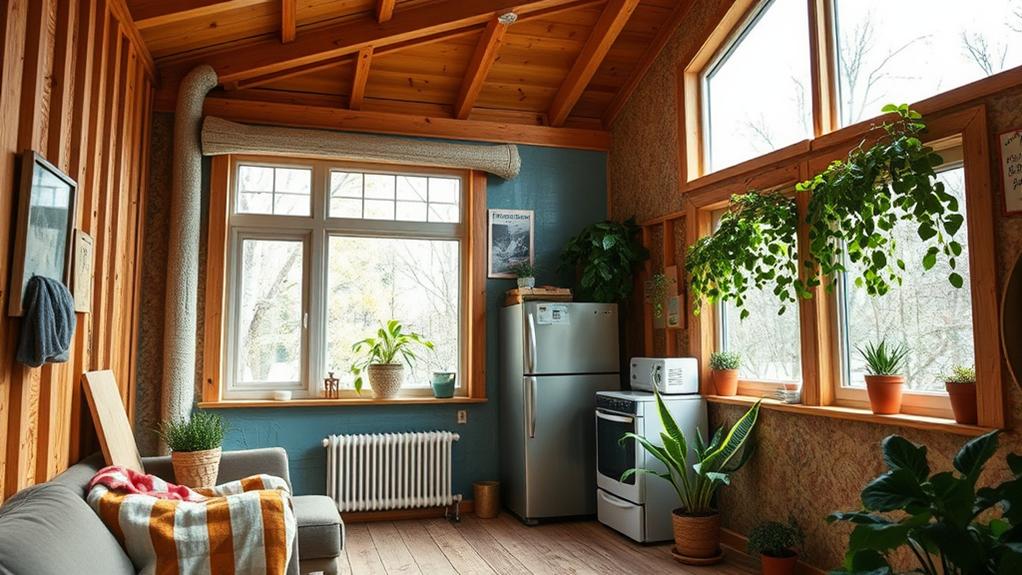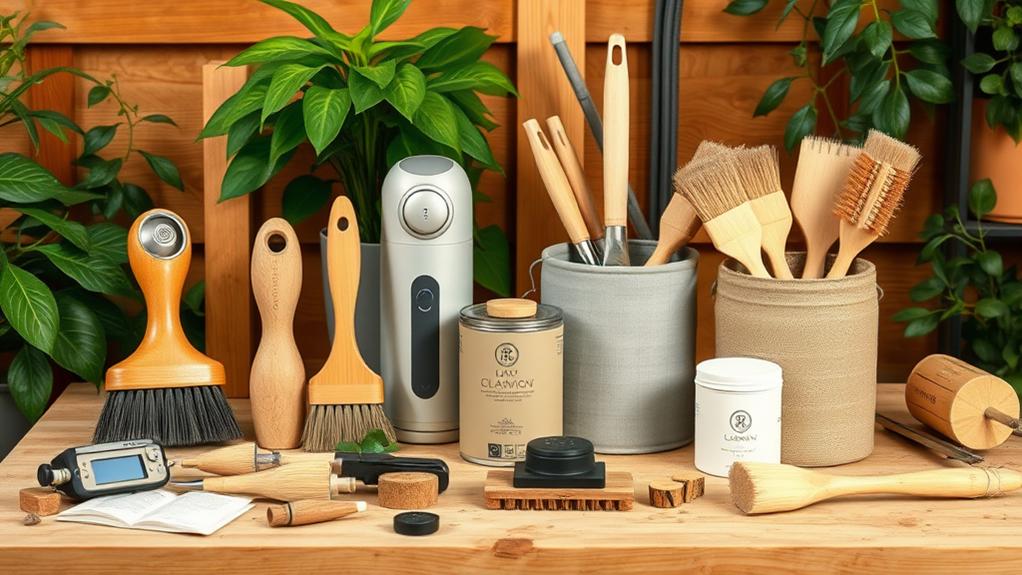When it comes to enhancing your home's energy efficiency, you might be surprised by how many effective DIY upgrades are at your fingertips. From installing a smart thermostat to switching out your old bulbs for energy-efficient LEDs, there's a range of options that can lead to significant savings. You could also consider upgrading your insulation or even tackling solar panel kits. Each choice offers unique benefits, but some may surprise you with their impact. Let's explore the most effective upgrades and what they can do for your home.
Smart Thermostat Installation
Installing a smart thermostat can greatly enhance your home's energy efficiency while providing you with greater control over your heating and cooling systems. By opting for this upgrade, you can adjust your home's temperature remotely through your smartphone, allowing you to save energy when you're away.
You'll have the flexibility to create a custom schedule that fits your lifestyle, guaranteeing that your heating and cooling only operate when necessary.
The installation process is typically straightforward. First, turn off the power to your HVAC system to guarantee safety. Remove the old thermostat and take note of the wiring. Connect the wires to the corresponding terminals on the smart thermostat, following the manufacturer's instructions.
Once everything is securely connected, mount the thermostat on the wall and restore power to your HVAC system.
After installation, download the associated app and follow the setup instructions. You'll soon be able to monitor your energy usage, receive alerts, and make adjustments from the convenience of your device.
With a smart thermostat, you'll not only enjoy increased comfort but also reduce your energy bills, making it a smart investment for your home.
LED Lighting Conversion
Upgrading to LED lighting is another effective way to boost your home's energy efficiency. LED bulbs use up to 80% less energy than traditional incandescent bulbs, translating to lower electricity bills.
Plus, they last considerably longer—often up to 25,000 hours—so you won't be constantly replacing them.
Start your conversion by identifying the areas in your home where you use the most lighting. Replace incandescent and CFL bulbs with LED alternatives.
When shopping, look for bulbs with the Energy Star label for quality assurance. They come in various shapes and brightness levels, so you can find the perfect fit for any room.
Don't forget about dimmable LEDs if you enjoy adjusting the ambiance of your space.
Verify your existing dimmer switches are compatible, or consider upgrading to ones designed for LEDs.
Energy-Efficient Windows
Energy-efficient windows can dramatically reduce your home's energy consumption and enhance comfort year-round. By upgrading to these windows, you'll minimize heat loss in winter and keep your home cool in summer, ultimately lowering energy bills.
When choosing energy-efficient windows, look for features like double or triple glazing, low-E glass coatings, and argon or krypton gas fills. These elements work together to create better insulation and reduce heat transfer.
You might also consider window frames made from materials like vinyl or fiberglass, as they offer superior thermal performance compared to traditional wood or aluminum frames.
Installing energy-efficient windows can be a rewarding DIY project. Start by measuring your current windows accurately and selecting the right size and style for your home.
Make sure you have the right tools, including a level, caulk gun, and insulation materials.
As you replace your old windows, pay attention to sealing and caulking to prevent air leaks. This upgrade not only enhances your home's energy efficiency but also boosts its curb appeal.
With the right windows, you'll enjoy a more comfortable living space while saving money on energy costs.
Insulation Upgrades
A well-insulated home can greatly enhance your comfort and lower energy bills. One of the best places to start is by checking your attic. Insulating your attic can prevent heat from escaping in winter and keep it cool in summer. You can use fiberglass batts or spray foam insulation for better results. Just make sure to wear protective gear when handling insulation materials.
Next, focus on your walls. If your walls lack insulation, consider adding foam board or blown-in cellulose. This can notably reduce drafts and maintain a consistent temperature throughout your home.
Don't forget about your floors, especially if you have an unconditioned basement or crawl space. Insulating the floor can help keep those chilly drafts at bay. Use rigid foam board or fiberglass batts to get the job done.
Lastly, check for gaps around windows and doors. Sealing these with caulk or weatherstripping can further enhance your insulation efforts.
Solar Panel DIY Kits
Once you've tackled insulation upgrades, it's time to explore the benefits of solar panel DIY kits. These kits provide a fantastic opportunity for you to harness renewable energy and reduce your electricity bills.
With a little research and basic tools, you can install solar panels on your roof and generate clean energy right at home. Most solar panel DIY kits include everything you need, like solar panels, mounting hardware, and inverters. They often come with detailed instructions, making installation manageable for those with a bit of handyman experience.
You'll want to assess your roof's orientation and shading to guarantee ideal sunlight exposure for maximum efficiency. Additionally, many local governments offer incentives for installing solar panels, which may help offset costs.
Keep in mind that while DIY installation is rewarding, you should always check building codes and regulations in your area.
Weatherstripping Techniques
Sealing gaps and cracks around your home can make a significant difference in energy efficiency, and weatherstripping is one of the easiest ways to do it.
By preventing drafts, you'll not only feel more comfortable but also save on heating and cooling costs. Here are some effective weatherstripping techniques you can use:
- Adhesive-backed foam tape: Perfect for irregular gaps around windows and doors, it's easy to install and offers good insulation.
- V-strip weatherstripping: Ideal for double-hung windows and sliding doors, this flexible material can be tucked into the cracks to block air leaks.
- Door sweeps: Installing a door sweep at the bottom of exterior doors prevents cold air from seeping in and helps keep heated air from escaping.
- Magnetic weatherstripping: Great for metal doors, this type snaps into place effortlessly and creates a tight seal.
Before you start, make sure to clean the surfaces thoroughly for better adhesion.
Take your time measuring and cutting, and you'll see just how much of a difference these small upgrades can make!
With these techniques, you'll enhance your home's energy efficiency in no time.
Smart Home Energy Monitors
With advancements in technology, smart home energy monitors have become essential tools for tracking and managing your energy usage. These devices provide real-time data on how much energy your home consumes, helping you identify areas where you can save.
You can easily connect them to your Wi-Fi, allowing you to monitor your energy consumption remotely through your smartphone or tablet.
By using smart home energy monitors, you gain insights into your energy habits. You can see which devices consume the most energy and adjust your usage accordingly. Some monitors even send you alerts when you exceed set thresholds, making it easier to stay within your budget.
Additionally, many models offer features like energy usage history, cost estimates, and energy-saving tips tailored to your household. This information empowers you to make informed decisions about energy efficiency upgrades.
Incorporating a smart home energy monitor into your DIY energy upgrades can lead to significant savings on your utility bills. The more you understand your energy consumption patterns, the better equipped you'll be to implement strategies that promote efficiency and sustainability in your home.
High-Efficiency Appliances
Understanding your energy consumption through smart home energy monitors sets the stage for making impactful upgrades, such as investing in high-efficiency appliances.
These appliances use advanced technology to reduce energy usage without compromising performance, helping you save money on utility bills while being kinder to the environment.
When choosing high-efficiency appliances, consider the following:
- Energy Star rating: Look for appliances with the Energy Star label, as they meet strict efficiency guidelines.
- Inverter technology: This technology adjusts the motor speed based on demand, making devices like refrigerators and air conditioners run more efficiently.
- Smart features: Appliances that connect to your smart home system can optimize energy use based on your habits.
- Size and capacity: Choose the right size for your needs; larger appliances can waste energy if they're underutilized.
Rainwater Harvesting Systems
Sustainability is at the heart of rainwater harvesting systems, which allow you to capture and utilize rainwater for various household needs. By implementing such a system, you can greatly reduce your reliance on municipal water sources, saving both money and resources.
To set up a rainwater harvesting system, start by installing gutters and downspouts on your roof to direct rainwater into a storage tank. Choose a tank that suits your space and needs—options range from simple barrels to larger, underground cisterns.
Make sure the tank is covered to prevent contamination and mosquito breeding. Next, consider installing a filtration system to keep the water clean for non-potable uses, like irrigation or toilet flushing.
You might also want to include a first-flush diverter, which directs the initial dirty runoff away from your storage tank. With proper maintenance, such as regular cleaning of gutters and checking for leaks, your rainwater harvesting system will provide you with a sustainable and efficient water source.
Not only will you be contributing to environmental conservation, but you'll also enjoy the satisfaction of managing your own water supply.
DIY Energy Audits
Conducting a DIY energy audit can reveal hidden opportunities to enhance your home's efficiency and lower your energy bills. By taking a systematic approach, you'll identify areas where energy is wasted and find practical solutions to improve your home's performance.
Start by gathering the right tools, like a notepad, flashlight, and thermometer.
Here are some key steps to follow during your audit:
- Inspect insulation: Check your attic, walls, and floors for adequate insulation. If it's lacking, consider adding more to keep your home comfortable.
- Seal leaks: Look for drafts around windows, doors, and electrical outlets. Use caulk or weatherstripping to seal these gaps and prevent energy loss.
- Evaluate appliances: Assess your appliances' energy usage. Consider replacing older models with energy-efficient options that consume less power.
- Monitor lighting: Switch out incandescent bulbs for LED options, which use considerably less energy and last longer.
After completing your audit, compile your findings and prioritize upgrades.
Small changes can lead to big savings, making your home more energy-efficient and comfortable in the long run.
Happy auditing!
Conclusion
By investing a little time and effort into these DIY energy upgrades, you can transform your home into an efficient haven while saving money on bills. Sure, you might worry about the upfront costs, but imagine walking into a cozy, well-lit space where your energy usage is optimized. Picture the satisfaction of knowing you're not only cutting costs but also contributing to a greener planet. Embrace these upgrades, and watch your home—and your savings—thrive!











